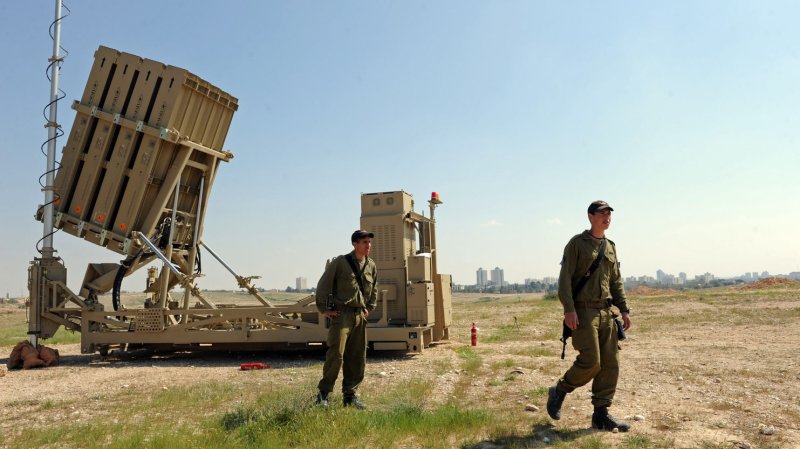Israeli soldiers stand near the Iron Dome, a new anti-rocket system, stationed near the southern city of Beersheba, Israel, March 27, 2011. The Israeli Defense Force deployed the $200 million Iron Dome system in response to dozens of rockets fired by Palestinian militants from Gaza in the past weeks. The Iron Dome is meant to protect Israeli towns from rockets fired from Gaza. UPI/Debbie Hill |
License Photo
TEL AVIV, Israel, June 25 (UPI) -- Israel's Iron Dome counter-rocket system, winner of this year's Israel Defense Prize, is in action again battling a Palestinian missile barrage but Rafael Advanced Defense Systems is developing a more advanced and deadlier variant.
It's expected to be operational by mid-2013. An even more advanced Block 3 model is to follow to boost Israel's growing air-defense shield against everything from Iranian ballistic missiles to short-range unguided rockets.
Over the last week, some 150 rockets and Russian-built Grad missiles have been fired into southern Israel from the Hamas-ruled Gaza Strip and the Egypt's increasingly lawless Sinai Desert.
At least six of the weapons were intercepted by Iron Dome batteries deployed to protect the southern cities of Beersheba, Ashkelon and Ashdod.
Iron Dome's central computer system can determine from the trajectories of incoming missiles which might hit populated areas. It concentrates on destroying them with mini-rocket Tamir interceptors, ignoring projectiles the computer determines will hit uninhabited areas.
Iron Dome first saw action in southern Israel in April 2011 and proved effective in knocking down Qassam rockets built by Hamas in makeshift workshops in Gaza and the factory-produced Grads smuggled in through underground tunnels from Sinai.
Rafael's current project is to boost the range of Iron Dome so it can help intercept longer range weapons, The Jerusalem Post says.
This appears to be a stopgap measure to cover holes in Israel's planned multilayered missile defense system until David's Sling, another system under development by state-owned Rafael and the U.S. firm Raytheon Co., becomes operational.
The Israelis are focusing on technological upgrades for the system, as well as amending the operational doctrine of the air force, which has charge of the emerging multilayered missile shield.
A modified system underwent a series of tests to determine the feasibility of using Iron Dome against longer-range missiles.
The current upgrade stems in part from a need to iron out kinks in a complex weapon system that was rushed through the development stage because of pressure to counter the expanding rocket and missile threat against Israel.
The immediate objective is to boost its interception capabilities to a wider array of threats than those it was designed to handle, projectiles with a range band of 2.5-43 miles.
There's no system for countering missiles with ranges of up to 190 miles and won't be until David's Sling enters service some time in 2013.
The top layer of the multitier missile defense system is the Arrow-2, built by state-owned Israel Aerospace Industries to counter ballistic missiles at high altitudes.
A more advanced variant, the Arrow-3, is under development by IAI and U.S. company Boeing.
The thinking seems to be that Iron Dome could be improved to at least cover the mid-range threat, and possibly even ballistic missiles in the final stage of their trajectory that might slip through the Arrow defense layer.
Iron Dome's Tamir interceptors, each of which costs $50,000-$100,000, are usually fired in pairs to ensure a kill.
"This is significant since it would allow us to intercept more rockets with fewer batteries," a senior defense officer told The Jerusalem Post.
"Soon we'll update the system to Block 2," observed Lt. Col. Shabtai Ben-Hocher, who heads the Lower Layer Wing of the air force's Aerial Defense Division.
"The upgrade will allow us to additional interception capabilities, along with a variety of improvements that I can't specify.
"Beyond that ... the minute we discover a problem or fault, we fix it and improve immediately, so that if there were to be an escalation tomorrow, we wouldn't have any problems.
"In many cases, waiting until the next version is unveiled in not an option," Ben-Hocher said.
Since Iron Dome's combat debut 14 months ago, the four batteries now deployed have intercepted just over 100 Katyusha and Qassam unguided rockets and 122mm Grads.
Some senior military officials have boasted the system has a kill rate of 90 percent against those rockets it has engaged but other sources, more intimately involved with missile defense than political kudos insist the kill rate is more like 70-75 percent.
The upgrade project and plans for more Iron Dome batteries -- 20 are required for complete coverage of Israel -- have been boosted by the U.S. allocation of nearly $1 billion in funding for the Jewish state's missile defense.















